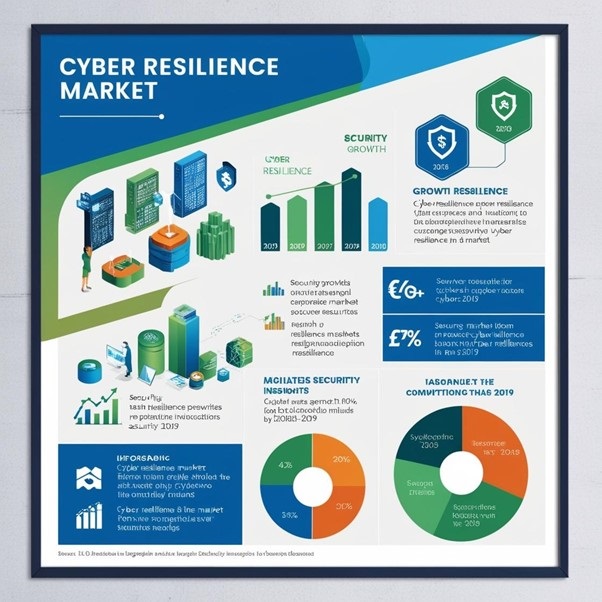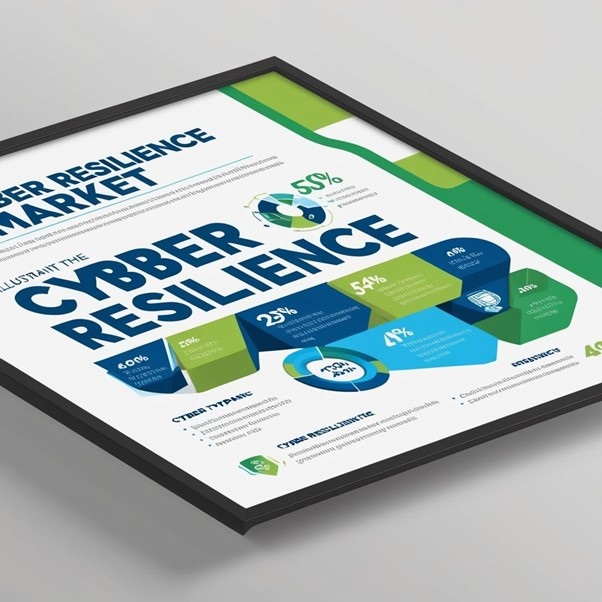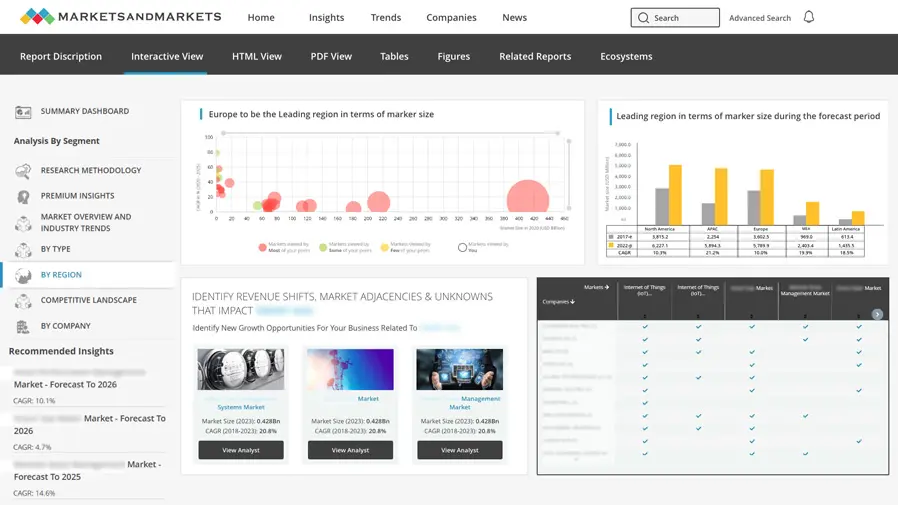Cyber Resilience Market by Technology (AI, IoT, Quantum Computing, Blockchain), Offering (Hardware, Software, Services), Application (Data Security, Network Monitoring, Cloud Services), End-Use Industry (Government, Defense, Commercial, Healthcare) and Region – Global Forecast to 2030
Overview
The Cyber Resilience Market has become an essential component of modern business strategy, especially in the wake of an increasing frequency and sophistication of cyber-attacks. As organizations continue to leverage digital technologies, the need for cyber resilience has grown significantly. Cyber resilience goes beyond traditional cybersecurity, focusing not just on protecting data and systems but also on ensuring business continuity in the event of a cyber incident. It is a proactive approach to mitigating risk, ensuring that businesses can withstand and recover from any cyber disruptions.

The global cyber resilience market is expected to grow substantially in the coming years. Factors such as the growing frequency of cyberattacks, the increasing sophistication of threats, and the need for business continuity have driven demand. Organizations are increasingly investing in solutions that provide not only protection but also quick recovery after an incident. As such, cyber resilience encompasses strategies like data backup, disaster recovery, threat detection, and business continuity planning. Additionally, the integration of artificial intelligence (AI), machine learning (ML), and automation in resilience solutions is making them more effective in real-time threat response and mitigation.
Attractive Opportunities
1. Cloud-based Cyber Resilience Solutions
The transition to cloud computing has opened up new opportunities for the cyber resilience market. Cloud-based solutions are becoming increasingly popular due to their scalability, cost-efficiency, and ease of integration with existing IT infrastructures. These solutions offer enhanced disaster recovery and data backup features, enabling organizations to recover from cyberattacks swiftly.
2. AI and Machine Learning Integration
AI and machine learning have proven to be game-changers in the field of cyber resilience. By integrating these technologies, organizations can predict, detect, and respond to cyber threats in real time. AI-driven resilience solutions analyze vast amounts of data to identify patterns that could indicate a potential cyberattack, thereby enabling proactive defense measures.
3. Rising Awareness of Business Continuity Planning
With the growing reliance on digital infrastructure, businesses are becoming increasingly aware of the importance of cyber resilience. Organizations are prioritizing resilience as part of their business continuity planning, leading to greater demand for solutions that can ensure that operations continue without significant disruptions during a cyberattack or failure.
4. Regulatory Compliance and Standards
Government regulations and industry standards regarding data protection and business continuity are driving demand for cyber resilience solutions. As organizations face increasing regulatory scrutiny, they are required to meet strict compliance standards. This presents an attractive opportunity for market players offering solutions that help businesses comply with regulations while ensuring data protection and recovery capabilities.
5. SMEs Adoption of Cyber Resilience Solutions
Historically, cyber resilience solutions have been adopted primarily by large enterprises. However, small and medium-sized enterprises (SMEs) are increasingly recognizing the need to protect their digital assets and ensure operational continuity. The rise of affordable, scalable cyber resilience solutions is making it easier for SMEs to adopt these strategies.

Global Market Dynamics
Drivers
- Increasing Cybersecurity Threats: Cyberattacks, such as ransomware, phishing, and data breaches, have increased in both frequency and sophistication. The rise in cybercrime and cyber espionage activities is driving the demand for more robust cyber resilience solutions.
- Regulatory Pressures: Data protection regulations, such as GDPR and CCPA, and industry-specific standards (e.g., HIPAA for healthcare) are pushing organizations to adopt more comprehensive resilience strategies to stay compliant and avoid fines.
- Digital Transformation and Cloud Adoption: As more organizations move to the cloud and adopt digital transformation strategies, they need to ensure that their operations are not disrupted by cyber incidents, further driving the adoption of cyber resilience solutions.
Restraints
- High Cost of Implementation: For many organizations, especially SMEs, the cost of implementing comprehensive cyber resilience solutions can be prohibitive. This could slow adoption, particularly in developing regions.
- Lack of Skilled Workforce: The implementation of cyber resilience strategies requires specialized knowledge. A shortage of cybersecurity professionals can hinder the adoption of these solutions in certain markets.
Opportunities
- AI-driven Solutions: As AI and machine learning technologies evolve, they present new opportunities for enhancing the efficacy of cyber resilience solutions. AI-based tools can help organizations predict and counter cyber threats more effectively.
- SME Market Growth: As mentioned, SMEs are increasingly adopting cyber resilience solutions, presenting untapped growth potential for solution providers targeting this segment.
Challenges
- Evolving Threat Landscape: The constantly changing nature of cyber threats means that cyber resilience solutions must continuously evolve to keep up with new attack vectors. Organizations must ensure that their resilience plans remain up-to-date, which can be resource-intensive.
- Complexity of Integration: Integrating cyber resilience solutions into existing IT systems can be complex, particularly for legacy infrastructure. The need for seamless integration can be a barrier to adoption.
Global Market Ecosystem Analysis
The cyber resilience market ecosystem consists of several key stakeholders, including solution providers, system integrators, distributors, and end-users. The market is largely fragmented, with various players offering specialized solutions in areas such as data backup, threat detection, and disaster recovery. Leading players in the market include companies like IBM Corporation, Cisco Systems, Inc., and Palo Alto Networks, Inc., among others.
The ecosystem also includes various verticals such as telecommunications, healthcare, finance, and manufacturing, each with its own unique needs and challenges related to cyber resilience. For instance, the healthcare sector requires robust solutions to protect sensitive patient data, while the telecommunications industry must ensure that their networks remain operational during a cyberattack.
In addition, the role of Managed Security Service Providers (MSSPs) is growing, as they offer tailored services to small and medium enterprises, who may not have the resources to build in-house cyber resilience teams.
Recent Developments of the Market
- Increased Adoption of AI and Machine Learning: Several companies are now integrating AI and ML into their cyber resilience offerings to enhance threat detection and response capabilities.
- Cloud-based Solutions: The move towards cloud-based cyber resilience services is accelerating, with vendors offering scalable, on-demand solutions for data backup, disaster recovery, and network security.
- Partnerships and Acquisitions: Leading players in the cyber resilience market are forming strategic partnerships and acquisitions to expand their product portfolios. For example, Cisco recently acquired a cyber resilience company to enhance its disaster recovery solutions.
Key Market Players
- IBM Corporation
- Cisco Systems, Inc.
- Palo Alto Networks, Inc.
- Fortinet, Inc.
- Trend Micro Inc.
- Check Point Software Technologies Ltd.
- Barracuda Networks
- Acronis
- Zerto
- Veeam Software

Want to explore hidden markets that can drive new revenue in Cyber Resilience Market?
 Scope of the Report
Scope of the Report

Want to explore hidden markets that can drive new revenue in Cyber Resilience Market?

This report offers a comprehensive analysis of the cyber resilience market by technology (AI, IoT, Quantum Computing, Blockchain), offering (hardware, software, services), application (data security, network monitoring, cloud services), and end-use industries (government, defense, commercial, healthcare). It provides insights into key market trends, growth drivers, challenges, and opportunities, as well as forecasts for market growth from 2024 to 2030. The report also covers regional market analysis, including North America, Europe, Asia-Pacific, Latin America, and the Middle East and Africa.
Frequently Asked Questions (FAQs):
What is cyber resilience??
Cyber resilience is the ability of an organization to maintain operations despite cyberattacks and disruptions. It involves not only protecting against cyber threats but also ensuring business continuity in the face of cyber incidents.
What factors are driving the growth of the cyber resilience market?
Key factors driving market growth include the increasing frequency and sophistication of cyberattacks, regulatory pressures, and the rising adoption of cloud and digital transformation strategies.
Which industries are expected to benefit most from cyber resilience solutions?
Key industries benefiting from cyber resilience include telecommunications, healthcare, finance, and government, all of which rely heavily on the secure and continuous operation of their digital infrastructure.
What technologies are being integrated into cyber resilience solutions?
Technologies such as AI, IoT, quantum computing, and blockchain are being integrated into cyber resilience solutions to improve threat detection, response, and overall system security.
Who are the leading players in the cyber resilience market?
Leading players in the cyber resilience market include IBM Corporation, Cisco Systems, Palo Alto Networks, Fortinet, and Trend Micro, among others.

Table of Contents
1. Executive Summary
- Key Findings
- Market Overview
- Market Forecast and Growth
2. Introduction
- Definition of Cyber Resilience
- Importance of Cyber Resilience in Today's Digital Landscape
- Scope and Objectives of the Report
3. Market Overview
- Global Cyber Resilience Market Trends
- Historical Market Size and Growth (2020–2024)
- Market Segmentation by Technology, Offering, Application, End-Use Industry, and Region
4. Attractive Opportunities
- Integration of AI and IoT for Proactive Resilience
- The Role of Blockchain in Securing Transactions
- The Future of Quantum Computing in Cybersecurity
- Cloud-Based Cyber Resilience Solutions
- Regulatory and Compliance Growth Opportunities
5. Global Market Dynamics
-
Market Drivers
- Increasing Cyber Threats and Attacks
- Regulatory Compliance and Data Protection Laws
- Demand for Business Continuity Solutions
-
Market Restraints
- High Implementation Costs
- Complexity of Integration
-
Market Opportunities
- AI and Machine Learning Advancements
- SME Adoption of Cyber Resilience Solutions
-
Challenges
- Evolving Cyber Threats
- Skilled Workforce Shortage
6. Global Market Ecosystem Analysis
- Key Stakeholders in the Cyber Resilience Market
- Role of Managed Security Service Providers (MSSPs)
- Impact of Cloud Computing on Cyber Resilience Solutions
- Market Landscape and Competitive Strategies
7. Recent Developments in the Market
- Technological Innovations in Cyber Resilience
- Key Mergers and Acquisitions
- Strategic Partnerships and Collaborations
- Advancements in AI-Powered Cyber Resilience
8. Key Market Players
- IBM Corporation
- Cisco Systems, Inc.
- Palo Alto Networks, Inc.
- Trend Micro Incorporated
- Fortinet, Inc.
- Check Point Software Technologies
- Zerto
- Acronis
- Veeam Software
- Barracuda Networks
9. Market Segmentation
-
By Technology:
- Artificial Intelligence (AI)
- Internet of Things (IoT)
- Quantum Computing
- Blockchain
-
By Offering:
- Hardware
- Software
- Services
-
By Application:
- Data Security
- Network Monitoring
- Cloud Services
-
By End-Use Industry:
- Government
- Defense
- Commercial
- Healthcare
-
By Region:
- North America
- Europe
- Asia Pacific
- Latin America
- Middle East & Africa
10. Regional Analysis
- North America Cyber Resilience Market
- Europe Cyber Resilience Market
- Asia Pacific Cyber Resilience Market
- Latin America Cyber Resilience Market
- Middle East & Africa Cyber Resilience Market
11. Competitive Landscape
- Overview of Market Share and Positioning
- Market Leaders and Emerging Players
- Competitive Strategies and Growth Tactics
12. Market Forecast (2024–2030)
- Global Market Size and Growth Forecast
- Regional Market Forecasts
- Segment-wise Growth Forecasts (by Technology, Offering, Application, End-Use Industry)
13. Key Takeaways
- Summary of Key Findings
- Market Outlook for Cyber Resilience Solutions
- Strategic Recommendations for Market Participants
14. Scope of the Report
- Research Methodology
- Data Sources and Assumptions
- Limitations of the Study














Growth opportunities and latent adjacency in Cyber Resilience Market